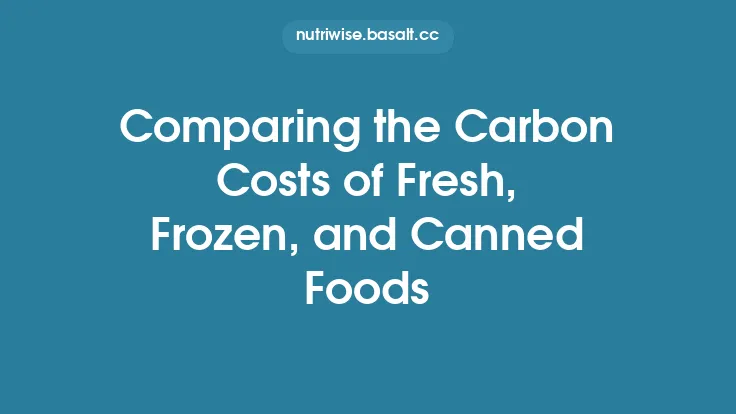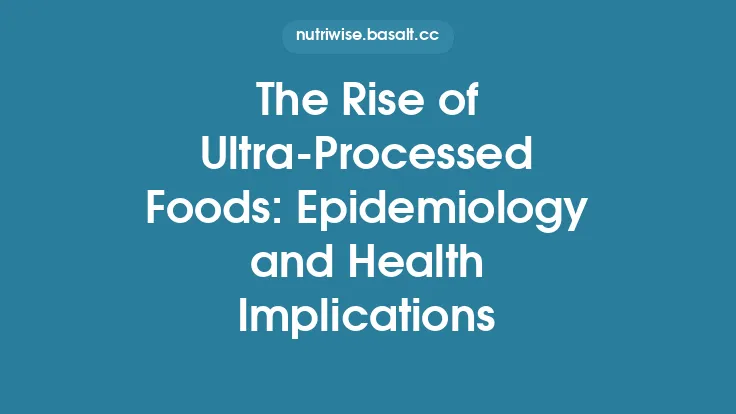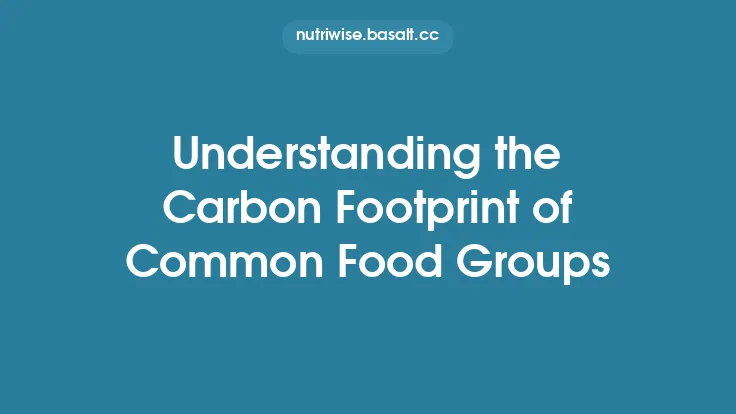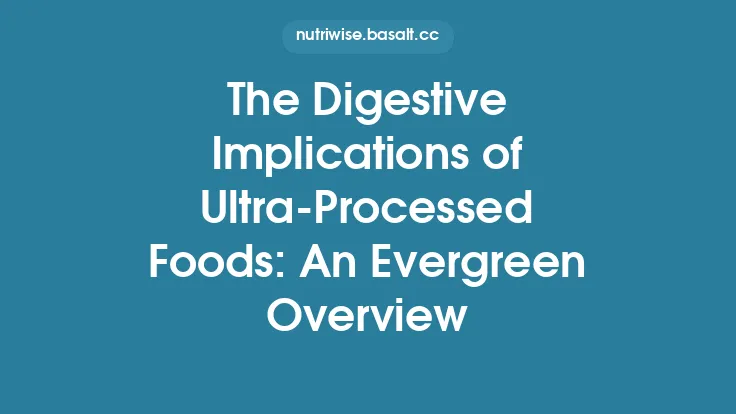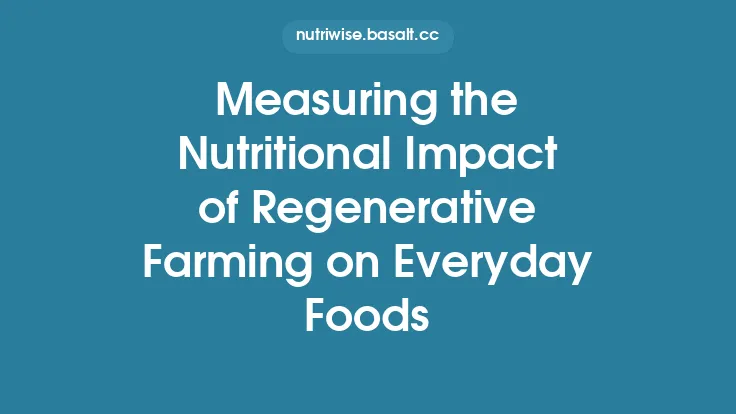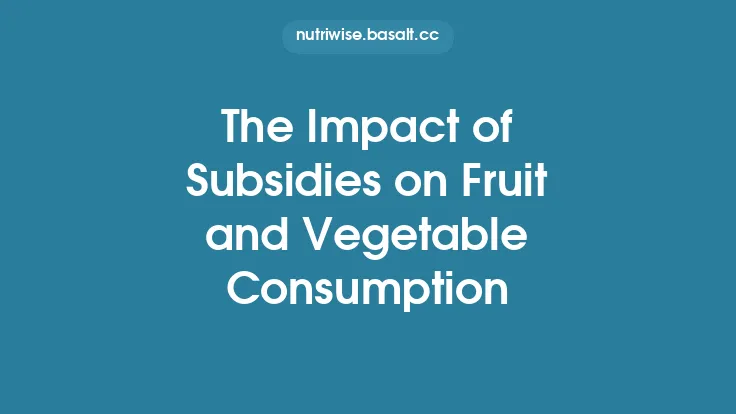Processed and packaged foods dominate modern grocery shelves, yet their carbon impact often remains hidden behind appealing branding and convenience claims. While the convenience of a ready‑to‑eat meal or a snack bar is undeniable, the journey from raw agricultural inputs to a sealed package involves multiple energy‑intensive steps, each contributing greenhouse‑gas (GHG) emissions. Understanding where these emissions arise, how they are measured, and what can be done to mitigate them is essential for anyone seeking a truly sustainable diet. This article unpacks the carbon footprint of processed and packaged foods by examining each stage of their life cycle, the technologies that drive emissions, and practical ways to assess and reduce the impact of the products we buy.
Understanding the Life‑Cycle Stages of Processed Foods
A comprehensive carbon assessment begins with a life‑cycle perspective, which maps every phase a food product undergoes from cradle to grave. For processed and packaged foods, the typical stages include:
- Ingredient Production – Cultivation, harvesting, and primary processing of raw agricultural commodities (e.g., grains, legumes, meat, dairy).
- Ingredient Processing & Refinement – Conversion of raw inputs into refined components such as flours, oils, sugars, protein isolates, and additives.
- Formulation & Manufacturing – Mixing, cooking, extrusion, drying, or other transformations that create the final product.
- Packaging Manufacture – Production of primary (direct contact) and secondary (outer) packaging materials.
- Distribution to Retail – Transportation and warehousing of finished goods (addressed only insofar as it interacts with processing and packaging).
- Consumer Use & Disposal – Opening, consumption, and post‑use handling of packaging waste.
Each stage carries distinct carbon intensities, and the relative contribution of each can vary dramatically across product categories. For instance, a high‑protein snack bar may have a larger share of emissions from ingredient processing (protein isolate production) than from packaging, whereas a single‑serve soup might be dominated by the energy used in canning and sterilization.
Energy Demands of Food Processing Operations
Food processing is fundamentally an energy‑intensive activity. The primary energy sources—electricity, natural gas, steam, and, in some regions, coal—fuel a suite of equipment:
| Process | Typical Energy Use (kWh / tonne product) | Key Emission Drivers |
|---|---|---|
| Milling & Grinding | 150–300 | Motor-driven crushers, dust collection |
| Thermal Processing (e.g., pasteurization, sterilization) | 400–800 | Steam generation, heat exchangers |
| Extrusion & Shaping | 250–500 | High‑pressure screw drives, cooling |
| Drying (air, spray, freeze) | 600–1,200 | Large fans, refrigeration cycles |
| Fermentation & Enzyme Treatment | 100–250 | Controlled temperature, agitation |
The carbon intensity of these processes depends not only on the amount of energy consumed but also on the carbon intensity of the local grid. In regions where electricity is generated largely from fossil fuels, the same kilowatt‑hour can emit 0.6–0.9 kg CO₂e, whereas renewable‑heavy grids may emit less than 0.1 kg CO₂e per kWh. Consequently, manufacturers that locate energy‑intensive plants near low‑carbon power sources can achieve substantial emissions reductions.
Process‑Specific Hotspots
- High‑Temperature Sterilization: Canned soups and ready‑to‑eat meals often require temperatures above 121 °C for several minutes, demanding large steam volumes. The associated emissions can represent up to 30 % of the product’s total carbon footprint.
- Drying Operations: Spray‑drying of milk powders or whey proteins consumes significant heat and airflow, making it one of the most carbon‑intensive steps in dairy‑derived snack production.
- Extrusion for Snack Foods: While extrusion is efficient for shaping, the combination of high shear forces and rapid heating can lead to high electricity consumption, especially when multiple product lines run concurrently.
Carbon Implications of Ingredient Sourcing and Formulation
Even before a product reaches the factory floor, the choice of ingredients sets a baseline carbon budget. Two key considerations dominate:
- Agricultural Emission Profiles – Crops such as soy, corn, and wheat have relatively low per‑kilogram GHG emissions (≈0.3–0.6 kg CO₂e kg⁻¹), whereas animal‑derived ingredients (meat, dairy, eggs) can exceed 10 kg CO₂e kg⁻¹. The inclusion of high‑impact animal proteins in processed foods dramatically raises the overall footprint.
- Ingredient Processing Intensity – Turning raw soybeans into soy protein isolate involves de‑hulling, extraction, precipitation, and drying, each adding 2–4 kg CO₂e kg⁻¹ of protein. Similarly, refined sugars require multiple crystallization steps, contributing additional emissions.
Formulation decisions—such as substituting a portion of animal protein with plant‑based alternatives, or using pre‑fermented doughs that require less baking time—can shift the carbon balance. However, these changes must be evaluated holistically, as some plant‑based processing (e.g., high‑temperature extrusion) may offset gains if not optimized.
Packaging Materials and Their Carbon Profiles
Packaging serves three essential functions: protection, preservation, and marketing. The carbon cost of packaging varies widely across material types:
| Material | Approx. GHG Emissions (kg CO₂e kg⁻¹) | Typical Use in Processed Foods |
|---|---|---|
| PET (polyethylene terephthalate) | 2.0–3.5 | Beverage bottles, single‑serve sauces |
| HDPE (high‑density polyethylene) | 1.5–2.5 | Milk jugs, bulk containers |
| Aluminum (cans) | 8–12 | Canned soups, beverages |
| Glass | 0.7–1.2 (per kg) | Jars for sauces, preserves |
| Paperboard (cardboard) | 0.6–1.0 | Secondary packaging, cartons |
| Bioplastics (PLA, PHA) | 1.5–3.0 (production) | Emerging snack wrappers |
Key factors influencing the carbon impact of packaging include:
- Material Production Energy: Aluminum smelting is especially carbon‑intensive, but the high recyclability of aluminum can offset this if recycling rates are high.
- Weight-to‑Volume Ratio: Heavier packaging (e.g., glass) requires more material per unit of product, increasing transport emissions indirectly.
- Recyclability and End‑of‑Life Management: Materials that are widely recycled (PET, aluminum) can achieve a “closed‑loop” carbon benefit, reducing the need for virgin material production.
Manufacturers increasingly adopt lightweighting—reducing material thickness—to cut both material use and associated emissions. However, overly thin packaging can compromise product integrity, leading to higher food waste, which in turn raises the overall carbon footprint.
End‑of‑Life Scenarios: Waste, Recycling, and Emissions
The carbon story does not end at the point of purchase. How packaging is disposed of influences the net emissions:
- Landfilling: Non‑recyclable plastics degrade slowly, releasing methane (CH₄) and other gases over decades. While the direct CO₂e from plastic degradation is modest, the associated landfill gas capture inefficiencies can add 0.1–0.3 kg CO₂e per kg of waste.
- Incineration with Energy Recovery: Modern waste‑to‑energy plants can offset fossil fuel use by generating electricity, but the net carbon benefit depends on the plant’s efficiency and the carbon intensity of the displaced energy source.
- Recycling: Closed‑loop recycling of PET and aluminum can reduce virgin material demand by 70–90 %, translating into 1.5–3 kg CO₂e saved per kg of material recycled. The effectiveness hinges on collection rates and contamination levels.
Food manufacturers can influence end‑of‑life outcomes by designing recyclable packaging (e.g., mono‑material PET bottles) and providing clear labeling to guide consumer disposal.
Quantifying Carbon Footprint: Methodologies and Metrics
Accurate carbon accounting for processed foods relies on standardized life‑cycle assessment (LCA) frameworks. The most widely used guidelines include:
- ISO 14040/44 – Provides principles for LCA, including goal definition, inventory analysis, impact assessment, and interpretation.
- PAS 2050 – A publicly available specification for assessing the carbon footprint of goods and services, emphasizing GHG emissions.
- GHG Protocol Product Standard – Offers a tiered approach (Scope 1, 2, and 3 emissions) tailored for product-level analysis.
Key metrics derived from these methods are:
- Carbon Intensity (CI) – Expressed as kg CO₂e per kilogram of product (kg CO₂e kg⁻¹).
- Carbon Footprint per Serving – Useful for consumer‑facing labeling; calculated by multiplying CI by the typical serving size.
- Attributional vs. Consequential LCA – Attributional LCAs allocate emissions based on average industry data, while consequential LCAs model how changes (e.g., switching to a lower‑impact ingredient) would alter overall system emissions.
Data quality is a critical challenge. Primary data from manufacturers (energy use, material inputs) yields the most reliable results, but many assessments rely on secondary databases (e.g., Ecoinvent, Agri‑Footprint) that may not capture product‑specific nuances. Transparency in assumptions and sensitivity analysis are therefore essential for credible carbon estimates.
Industry Initiatives and Emerging Technologies
Recognizing the carbon implications of processing and packaging, several industry movements are gaining traction:
- Renewable Energy Commitments – Major food processors (e.g., Nestlé, Unilever) are pledging 100 % renewable electricity for manufacturing sites, directly cutting Scope 2 emissions.
- Carbon‑Neutral Processing – Pilot projects using biomass‑derived steam or green hydrogen for high‑temperature operations aim to eliminate fossil‑based heat.
- Advanced Packaging Materials – Development of nanocellulose films, mycelium‑based composites, and recyclable multilayer laminates seeks to combine barrier performance with lower carbon footprints.
- Digital Process Optimization – AI‑driven predictive maintenance and real‑time energy monitoring reduce unnecessary equipment run‑time, shaving up to 10 % off processing energy use.
- Circular Economy Models – Some brands are introducing refill stations for sauces and condiments, eliminating single‑use packaging altogether.
These initiatives illustrate that carbon reduction is not solely a matter of ingredient choice; it also hinges on systemic shifts in manufacturing technology and material science.
Guidelines for Consumers to Assess Carbon Impact
While detailed LCA data are often proprietary, consumers can make informed decisions using readily available cues:
- Read Ingredient Lists – Products with a high proportion of animal‑derived ingredients typically have larger carbon footprints.
- Look for Packaging Transparency – Labels indicating recyclable material (e.g., “100 % PET recyclable”) or certifications such as Recyclable Packaging Alliance suggest lower end‑of‑life emissions.
- Check for Carbon Labels – Some brands voluntarily display carbon intensity per serving (e.g., “0.45 kg CO₂e per 100 g”).
- Prefer Light‑Weight, Mono‑Material Packaging – These are easier to recycle and generally require less material production energy.
- Support Companies with Renewable Energy Commitments – Corporate sustainability reports often disclose energy sources; choosing products from such companies indirectly supports low‑carbon manufacturing.
By integrating these simple checks into shopping habits, consumers can collectively drive market demand toward lower‑impact processed foods.
Future Outlook and Research Gaps
The carbon assessment of processed and packaged foods is an evolving field. Key areas where further research could sharpen our understanding include:
- Dynamic LCA Models – Incorporating real‑time energy mix data to reflect seasonal variations in grid carbon intensity.
- Ingredient‑Specific Processing Emissions – Developing granular emission factors for emerging protein isolates (e.g., pea, fava bean) and novel sweeteners.
- Packaging‑Food Interaction Studies – Quantifying how barrier performance influences product shelf‑life and consequent food waste, thereby affecting overall carbon balance.
- Consumer Behavior Analytics – Understanding how labeling influences disposal practices and recycling rates for specific packaging types.
- Policy Impact Analyses – Evaluating the effectiveness of extended producer responsibility (EPR) schemes on reducing packaging‑related emissions.
As data quality improves and methodological consensus strengthens, the ability to compare products on a carbon basis will become more robust, empowering both industry and consumers to make choices that align with climate‑smart food systems.
In sum, the carbon impact of processed and packaged foods is a multifaceted issue that extends far beyond the simple act of buying a snack. By dissecting each life‑cycle stage—ingredient production, processing, packaging, and end‑of‑life—stakeholders can pinpoint the most emission‑intensive steps and implement targeted reductions. Whether through renewable energy adoption, material innovation, or informed consumer choices, the pathway to lower‑carbon processed foods is both technically achievable and increasingly visible on the market horizon.
